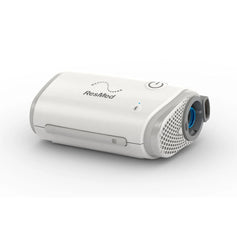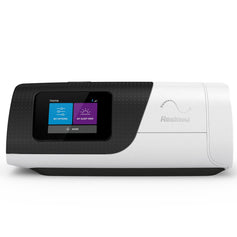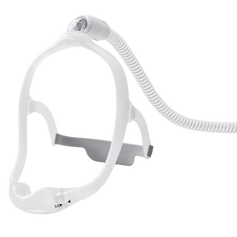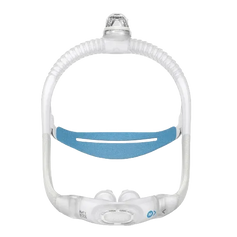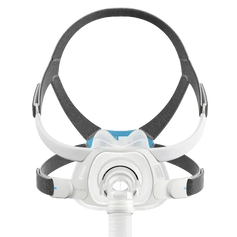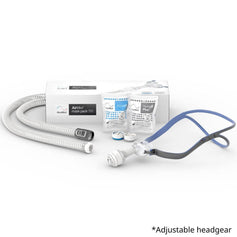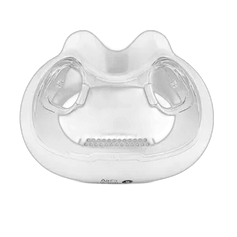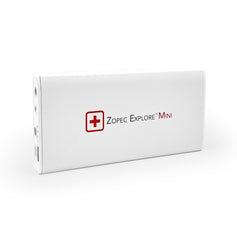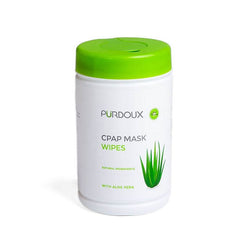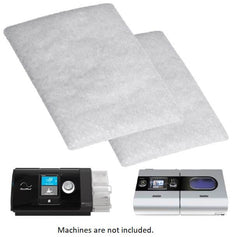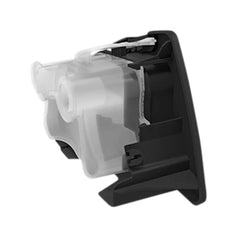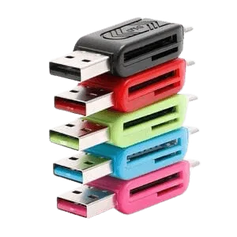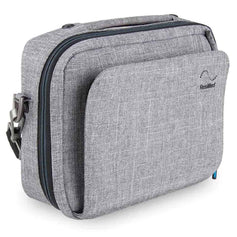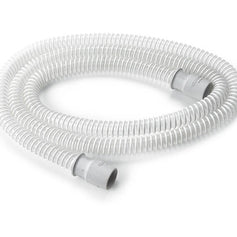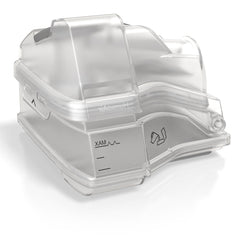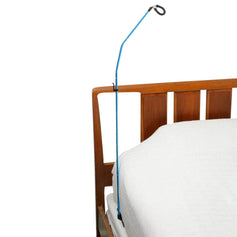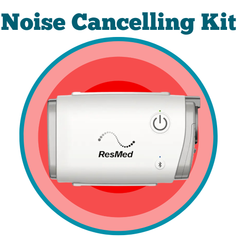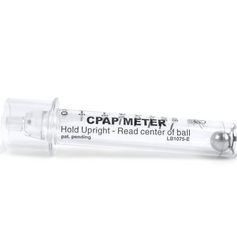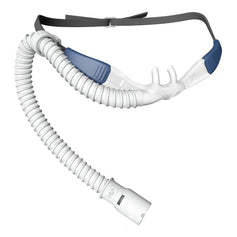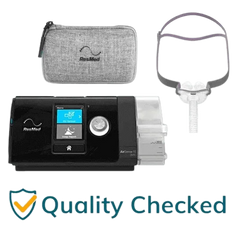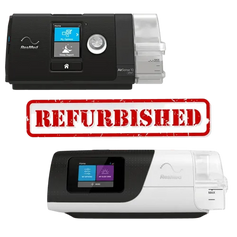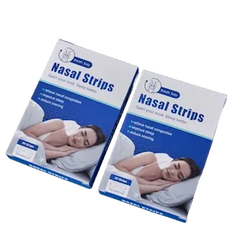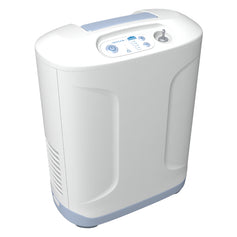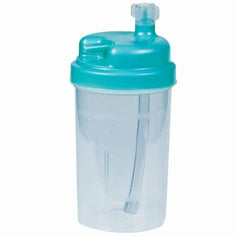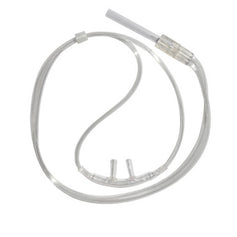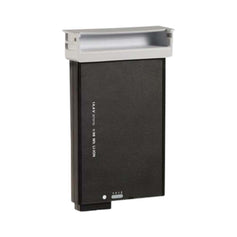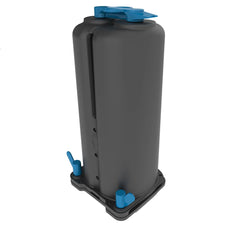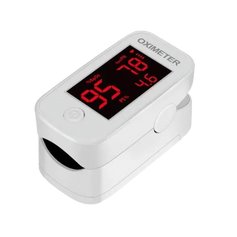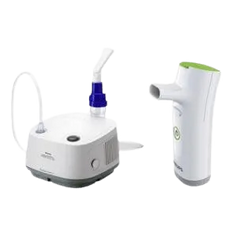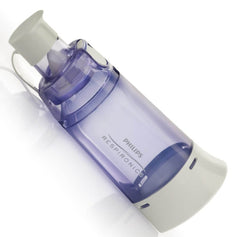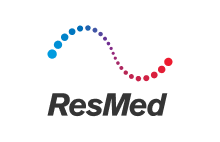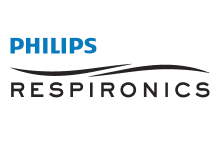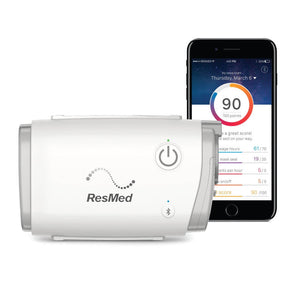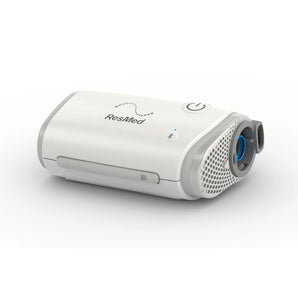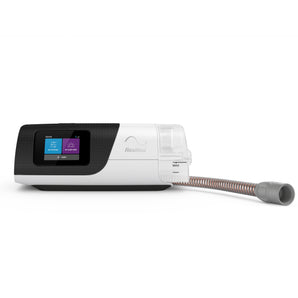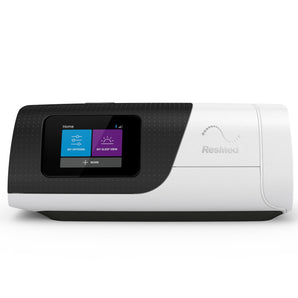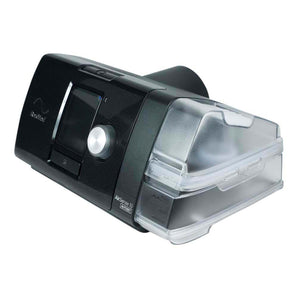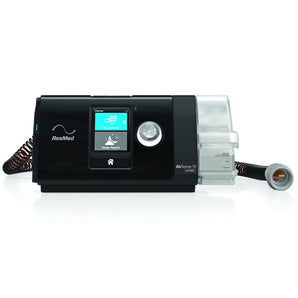Whether you’re new to sleep therapy or looking to brush up on clinical and equipment terminology, this glossary offers clear, practical definitions for the most commonly used concepts in sleep apnea care and positive airway pressure (PAP) therapy.
From device modes and mask types to data metrics and comfort features, you’ll find concise explanations that eliminate confusion and boost your confidence as a patient, caregiver, or informed shopper.
Use this resource to better understand what makes PAP therapy effective, comfortable, and sustainable, and how each component supports restful sleep and long-term adherence.
In this glossary, you’ll learn:
- Key differences between CPAP, APAP, and BiLevel therapies
- How features like humidification, ramp, and exhalation relief improve comfort and compliance
- Which accessories and maintenance schedules keep your equipment clean, reliable, and travel-ready
Apnea-Hypopnea Index (AHI)
A polysomnographic metric that quantifies the severity of sleep-disordered breathing by calculating the average number of apneas and hypopneas per hour of sleep. AHI is derived from in-laboratory overnight polysomnography and is expressed as events per hour.
Auto-Adjusting CPAP (APAP)
Auto-Adjusting CPAP (APAP) is a positive airway pressure modality for obstructive sleep apnea in which the device continuously adapts the delivered pressure within a prescribed range in response to airflow-based signals detected by embedded sensors and proprietary algorithms.
By increasing pressure when obstructive events or surrogates are identified and reducing pressure when breathing stabilizes, APAP aims to maintain airway patency while minimizing exposure to higher-than-necessary pressures.
The table below compares common PAP therapy modes, their pressure delivery, primary uses, and key benefits.
| Therapy Mode | Pressure Delivery | Primary Use | Key Benefit |
| CPAP (Continuous) | Constant fixed pressure | Obstructive Sleep Apnea (OSA) | Simple, stable airway patency |
| APAP (Auto-Adjusting) | Pressure varies in prescribed range based on sensors | OSA with variable pressure needs | Pressure optimization and comfort |
| BiLevel (BiPAP) | Two pressure levels: IPAP & EPAP | OSA and certain hypoventilation syndromes | Assists ventilation, reduces effort |
Auto Start/Stop
Auto start/stop (also called Auto On/Off or SmartStart/SmartStop) is a control feature in positive airway pressure (PAP) devices that automatically initiates therapy when patient breathing is detected at the mask interface and terminates airflow when the mask is removed or when a sustained absence of breathing/flow is detected.
The function uses internal flow and pressure sensors to analyze the respiratory signal and leak, applying manufacturer-defined thresholds to trigger start and stop events.
Battery Backup
A battery backup for CPAP equipment is an external or integrated rechargeable energy storage system designed to power a continuous positive airway pressure device during mains power interruptions or in off-grid use. It typically supplies direct current (DC) at a device-specific voltage via a dedicated DC/DC converter or, less efficiently, through an AC inverter.
BiLevel Positive Airway Pressure (BiPAP)
A noninvasive positive airway pressure (PAP) modality that delivers two preset pressure levels via a mask interface: a higher inspiratory positive airway pressure (IPAP) during inhalation and a lower expiratory positive airway pressure (EPAP) during exhalation.
The differential between IPAP and EPAP (pressure support) assists ventilation by augmenting tidal volume and unloading respiratory muscles, while EPAP helps maintain upper-airway patency and counteracts obstructive events.
Central Sleep Apnea (CSA)
A sleep-related breathing disorder characterized by recurrent episodes of absent or markedly reduced airflow during sleep due to absent or diminished respiratory effort, rather than upper airway obstruction.
Events are scored on polysomnography when there is at least a 90% drop in airflow for 10 seconds or longer with absent inspiratory effort throughout the event, distinguishing CSA from obstructive apneas, which feature continued respiratory effort against a closed or narrowed airway.
CPAP Filter
A CPAP filter is a replaceable air filtration component used in continuous positive airway pressure (CPAP) and other positive airway pressure devices to remove particulate and, when applicable, microbial contaminants from the air stream used for sleep apnea therapy.
CPAP systems typically employ an air inlet filter at the device intake to reduce exposure to common airborne particulates and may optionally use an in-line bacterial/viral filter placed in the breathing circuit to further reduce microbial load.
The following table outlines common CPAP filter types, their descriptions, and typical replacement intervals.
| Filter Type | Description | Replacement Frequency |
| Washable Filter | Reusable foam filter | Wash every 1-2 weeks, replace 6-12 months |
| Hypoallergenic Filter | Disposable fine particulate filter | Replace every 1-3 months |
| In-line Bacterial Filter | Single-use microbial barrier | Replace as per manufacturer, typically monthly |
CPAP Machine
A noninvasive respiratory device that delivers a constant, preset level of positive airway pressure via a patient interface (mask) to maintain upper airway patency during sleep. CPAP machines for sleep apnea are primarily indicated for the treatment of obstructive sleep apnea (OSA), where the continuous pressure acts as a pneumatic splint to prevent pharyngeal collapse and apnea-hypopnea events.
CPAP Mask
A patient interface designed to deliver continuous positive airway pressure from a CPAP device to the upper airway for the treatment of sleep-disordered breathing, most commonly obstructive sleep apnea. The mask forms a sealed connection to the patient’s nose and mouth and typically comprises a cushion, frame, headgear, swivel or elbow connector, and an exhalation vent for intentional leak to purge carbon dioxide.

Philips DreamWisp Nasal CPAP Mask
CPAP Pillow
A sleep accessory designed to accommodate a continuous positive airway pressure (CPAP) mask and tubing during sleep. Typical designs include side cutouts, contours, or channels that reduce contact between the pillow and the mask, aiming to minimize unintentional mask displacement and air leaks when sleeping laterally or prone.
Durable Medical Equipment (DME)
A category of medical devices that can withstand repeated use, are primarily and customarily used to serve a medical purpose, are generally not useful to an individual in the absence of illness or injury, and are appropriate for use in the home.
Under U.S. Medicare policy, DME is covered under Part B when medically necessary and prescribed by a qualified practitioner, and it may be provided on a purchase or rental basis depending on the item and regulatory requirements.
Exhalation Pressure Relief (EPR)
A proprietary comfort feature in certain ResMed continuous positive airway pressure (CPAP) devices that reduces delivered mask pressure during the expiratory phase to facilitate exhalation while maintaining the prescribed therapeutic pressure during inhalation.
Full-face Mask
A positive airway pressure (PAP) interface that covers both the nose and mouth to create a sealed conduit for pressurized airflow during sleep-disordered breathing therapy. A full-face mask for mouth-breathing is used with continuous or auto-adjusting PAP devices to treat obstructive sleep apnea and other conditions requiring noninvasive ventilation.
Gel Cushion
A gel cushion is the deformable sealing interface on certain CPAP and BiPAP masks, composed of a viscoelastic gel element often coupled with a thin silicone flap. The gel component conforms to facial contours under strap tension and operating pressures to create an airtight seal while distributing contact forces to reduce localized pressure points and leakage.
Heated Humidifier
An active humidification device used in positive airway pressure (PAP) systems, including continuous positive airway pressure (CPAP), to increase the water vapor content and temperature of inspired gas by warming a water reservoir.
Heated Tubing
A flexible breathing circuit for continuous positive airway pressure (CPAP) and bilevel positive airway pressure (BiPAP) systems that incorporates an embedded electrical heating element along the tube length to control gas temperature and reduce rainout within the circuit.
Humidity Level
In continuous positive airway pressure (CPAP) therapy, humidity level is the setting that controls the moisture content of the gas delivered to the patient. Humidity can be expressed as absolute humidity or as relative humidity measured at or near the mask interface.
Hypoallergenic Filter
A hypoallergenic filter is a disposable fine-particulate intake filter designed to reduce patient exposure to common airborne allergens (such as dust, pollen, pet dander, and mold spores) and to protect the device’s blower assembly from particulate ingress.

ResMed S8 Hypoallergenic CPAP Filters
In-line Bacterial Filter
A single-use barrier device placed within a breathing circuit to reduce the transmission of microorganisms and particulates. These filters commonly employ electrostatic or mechanical media and standardized ISO connectors for compatibility with respiratory equipment.
Integrated Humidifier
A humidification module built into a continuous positive airway pressure (CPAP) or bilevel PAP device’s chassis, designed to add heat and moisture to the delivered airflow to reduce upper-airway dryness and related side effects.
Integrated designs house the water chamber, heating plate, and control electronics within the primary device, enabling compact form factors, unified power/control, and coordinated features such as automatic humidity control and preheat functions.
Kink-resistant Tubing
Kink-resistant tubing is flexible medical-grade tubing designed to resist lumen collapse, occlusion, or flow restriction when subjected to bending, twisting, or external loads.
In positive airway pressure (PAP) applications such as continuous positive airway pressure (CPAP) therapy, kink-resistant tubing helps maintain prescribed airflow and pressure delivery between the device and patient interface by preserving cross-sectional patency throughout typical use conditions.
Latex-free Materials
Latex-free materials are substances and components manufactured without natural rubber latex derived from Hevea brasiliensis. In regulated healthcare contexts, the term specifically denotes products “not made with natural rubber latex,” a labeling convention recommended by the U.S. Food and Drug Administration due to the difficulty of verifying complete absence of latex contamination across complex supply chains.
Leak Rate
Leak rate is the volumetric flow of gas escaping from a continuous positive airway pressure (CPAP) or positive airway pressure (PAP) system, typically expressed in liters per minute (L/min).
In sleep apnea therapy, leak rate comprises two components: intentional leak (the designed vent flow of the mask to wash out exhaled carbon dioxide) and unintentional leak (air escaping from poor mask seal, mouth leak, or circuit disconnections).
Magnetic Headgear Clips
Magnetic headgear clips are magnet-based fasteners integrated into continuous positive airway pressure (CPAP) and bilevel (BiPAP) mask headgear to quickly attach and detach the headgear straps from the mask frame.
The clips typically house small permanent magnets embedded in the corresponding clip and frame components to provide repeatable alignment and secure retention while facilitating rapid donning and doffing and mask adjustment.
Mask Cushion
A mask cushion is the patient-contact component of a positive airway pressure (PAP) interface that forms the seal between the mask frame and the user’s face to contain therapeutic airflow and minimize unintentional leak during CPAP, APAP, or BiLevel therapy.

Philips DreamWisp CPAP Mask Cushion
Mask Fit
Mask fit (CPAP) refers to the adequacy of the mechanical seal and positional conformity between a positive airway pressure (PAP) mask interface and the user’s face under operating pressures during sleep.
It is determined by correct interface selection (e.g., nasal, nasal pillows, or oronasal), appropriate size and cushion geometry, and proper headgear tension, such that unintentional leak is minimized within manufacturer-defined limits while maintaining patient comfort and tolerance.
Mask Liner
A thin, removable fabric interface placed between a positive airway pressure (PAP) mask cushion and the user’s skin. Mask liners are typically made of cotton or similar breathable textiles and are designed to function as a barrier that absorbs facial moisture and oils, reduces friction and pressure-related skin markings, and may help stabilize the mask-to-skin interface to limit minor air leaks and noise.
Mask Wipes
Mask wipes are pre-moistened, single-use towelettes designed for surface cleaning of continuous positive airway pressure (CPAP) interfaces and accessories, including mask cushions, frames, and hard surfaces. They are typically formulated to be non-linting and free of alcohol, bleach, and strong solvents to maintain material compatibility with common CPAP mask polymers and silicone cushions.
Nasal Mask
A nasal mask is a noninvasive positive airway pressure (PAP) interface that covers the nose only and seals around the nasal bridge and nostrils to deliver therapeutic airflow from continuous or auto-adjusting PAP devices for the treatment of obstructive sleep apnea (OSA) and related sleep-disordered breathing.
Nasal Pillows
Nasal pillows are a type of positive airway pressure (PAP) mask interface designed to deliver pressurized airflow directly into the nares (nostrils) via soft, contoured inserts. They are commonly used with continuous positive airway pressure (CPAP), auto-adjusting CPAP (APAP), and bilevel PAP devices for the treatment of obstructive sleep apnea.
Obstructive Sleep Apnea (OSA)
Obstructive Sleep Apnea (OSA) is a sleep-related breathing disorder characterized by recurrent episodes of partial (hypopnea) or complete (apnea) upper airway obstruction during sleep, resulting in reduced or absent airflow despite ongoing respiratory effort.
These events lead to intermittent hypoxemia, hypercapnia, sleep fragmentation, and fluctuations in intrathoracic pressure, which can contribute to daytime sleepiness, neurocognitive impairment, and increased cardiometabolic risk.
Oxygen Enrichment Adapter
An oxygen enrichment adapter (also called an oxygen bleed-in adapter or oxygen enrichment port connector) is an inline connector used to introduce supplemental oxygen into a continuous positive airway pressure (CPAP), auto-CPAP (APAP), or bilevel (BiPAP) breathing circuit.
The adapter typically inserts between the device outlet and the breathing tube, or connects near the mask, and provides a dedicated barbed port for standard oxygen supply tubing.

Sunset Healthcare Oxygen Enrichment Adapter
Positive Airway Pressure (PAP) therapy
A noninvasive ventilatory modality that delivers pressurized air via a mask interface to maintain patency of the upper airway during sleep. It is primarily indicated for obstructive sleep apnea (OSA) and is also used in select cases of central sleep apnea (CSA), treatment-emergent CSA, and certain hypoventilation syndromes.
PAP reduces upper-airway collapsibility by providing a pneumatic splint, thereby lowering the apnea–hypopnea index (AHI), improving nocturnal oxygenation, and reducing arousals.
Pressure Ramp
Pressure ramp is a user-configurable comfort feature on positive airway pressure (PAP) devices (including CPAP, APAP, and bilevel systems) that begins therapy at a sub-therapeutic start pressure and gradually increases airway pressure to the prescribed therapeutic level over a defined interval. The ramp is intended to improve tolerance and sleep onset by reducing initial pressure load, without altering the clinician-set therapeutic target.
Rainout (Condensation)
Refers to the accumulation of liquid water inside a positive airway pressure (PAP) breathing circuit when humidified therapy air cools below its dew point. The temperature drop causes water vapor carried from the humidifier to condense on the inner surfaces of the hose and interface, leading to water pooling or “gurgling,” transient flow obstruction, increased leak, noise, and sleep disruption.
Ramp Time
A configurable feature of positive airway pressure (PAP) devices, including continuous positive airway pressure (CPAP) and auto-adjusting CPAP (APAP), that gradually increases delivered pressure from a lower “start” pressure to the prescribed therapeutic pressure over a set interval.
The function is intended to enhance comfort at sleep onset by reducing the initial pressure load and then incrementally reaching the therapeutic level once the patient is more likely to be asleep.
Replacement Schedule (Resupply)
The payer- and manufacturer-aligned intervals at which consumable components of Positive Airway Pressure (PAP) systems are replaced to maintain device performance, hygiene, and safety, and to meet coverage requirements.
In the United States, Medicare establishes nationally recognized maximum replacement frequencies for PAP accessories using HCPCS codes; many commercial insurers adopt similar limits.
Slim Tubing (15 mm)
A lightweight, small-bore CPAP breathing tube with an internal diameter of approximately 15 millimeters, used to deliver positive airway pressure from a CPAP/APAP/BiLevel device to the patient interface. Compared with standard tubing (commonly referred to as 22 mm), 15 mm slim tubes reduce bulk and mass, improving flexibility and comfort during sleep and travel.
Smart App Integration
The connectivity and data exchange between continuous positive airway pressure (CPAP) therapy devices and companion mobile or web applications. Implementations typically use short-range wireless protocols and networked interfaces to synchronize therapy metrics from the CPAP device to a patient-facing app and associated cloud service.
Standard Tubing (22 mm)
Non-heated, corrugated breathing hoses used with continuous positive airway pressure (CPAP) and bilevel positive airway pressure (BiPAP) devices that have a nominal 22 mm internal diameter and 22 mm conical end connectors.
The 22 mm connectors conform to standardized breathing system fittings used across respiratory and anesthetic equipment, enabling cross-compatibility between most CPAP devices, humidifiers, and masks.
Travel CPAP
A compact, lightweight positive airway pressure device designed for the treatment of obstructive sleep apnea outside the home. Travel CPAP devices provide therapeutic pressure typically within the standard CPAP/APAP range, and maintain core functionality of conventional PAP systems, including delivery of fixed or auto-adjusting pressure, event detection and logging, and compatibility with standard mask interfaces via dedicated or universal tubing adapters.
Tube Brush
A tube brush is a narrow, flexible, bristled cleaning implement designed to mechanically remove organic residue, biofilm, and particulate soil from the interior lumen of respiratory tubing used with positive airway pressure devices.
Typical designs use a stainless-steel or polymer coil shaft with nylon or similar soft bristles sized to match common PAP hose inner diameters and lengths sufficient to traverse typical 1.8–2.1 m hoses.
Water Chamber
A water chamber, also known as a water tub or humidifier reservoir, is the removable container in a continuous positive airway pressure (CPAP), bilevel (BiPAP), or automatic positive airway pressure (APAP) device’s heated humidifier assembly that holds water for vaporization and delivery of humidified airflow to the patient.
Washable Filter
A reusable, typically polyurethane foam intake filter used in continuous positive airway pressure (CPAP) and related PAP devices to capture larger particulates such as dust, lint, and pet dander before air enters the device.
Washable filters are designed to be periodically removed, rinsed with water (often with mild soap), thoroughly dried, and reinstalled. They are distinct from disposable “ultra-fine” or hypoallergenic filters, which are single-use.

